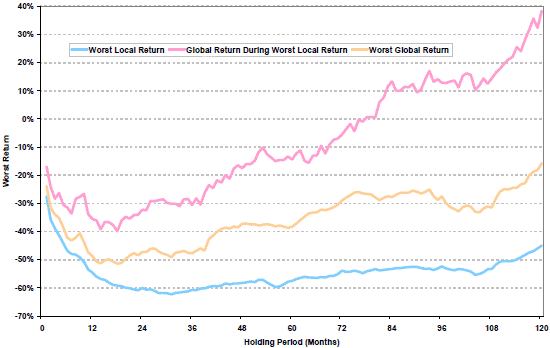Given the sometimes high correlations in movements among local equity markets, how valuable is international diversification in a global era? In the February 2010 draft of their paper entitled “International Diversification Works (in the Long Run)”, Clifford Asness, Roni Israelov and John Liew examine the argument that global markets are undiversified (correlated) when you need diversification and diversified (uncorrelated) when you don’t. They use an equally weighted 22-country global portfolio for their investigation. Using monthly local currency-denominated total returns, exchange rates and inflation data for Australia, Austria, Belgium, Canada, Denmark, Finland, France, Germany, Greece, Hong Kong, Ireland, Italy, Japan, Netherlands, Norway, Portugal, Singapore, Spain, Sweden, Switzerland, UK and U.S. for 1950-2008, they conclude that:
- Multiple expansion/contraction (economic performance) tends to dominate short-term (long-term) stock returns. Thus, while global diversification may not avoid terrible days, months or even years, it works well over long horizons for which economic growth matters more than short-lived panics and global events.
- The global portfolio tends to outperform local portfolios when local portfolios crash, but the global portfolio is still almost always down. Across all countries, the average worst monthly / quarterly / annual local returns are -27.5% / -38.8% / -54.5%, while the average contemporaneous returns for the global portfolio are -17.0% / -28.3% / -35.5%.
- On average, the worst monthly / yearly returns for the local portfolios are -27.5% / -54.5%, while the worst monthly / annual returns for the global portfolio are somewhat less severe -23.9% / -48.7%. Moreover, the global portfolio has a significantly lower volatility than local portfolios, so its worst returns are relatively rare events.
- As investing horizon lengthens, the contemporaneous average global portfolio outperforms the average worst case for local portfolios by a progressively wider margin (see the chart below). Investors holding portfolios for five years and longer realize obvious benefits from global diversification.
The following chart, taken from the paper, compares the average worst local return, the average contemporaneous 22-country global portfolio return and the worst global portfolio return for holding periods of one to 120 months during 1950-2008. The global portfolio is unhedged with respect to currency movements. The chart shows that the downside risk protection of global diversification generally grows with investing horizon.

In summary, evidence from 1950-2008 indicates that global diversification, while providing little protection on average from local market crashes, offers considerable risk mitigation over the long run.